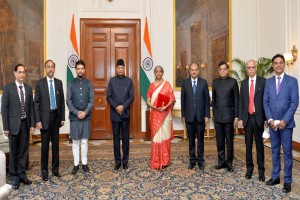
Union Finance and Corporate Affairs Minister Nirmala Sitharaman along with the Minister of State for Finance and Corporate Affairs, Anurag Singh Thakur and the senior officials presents the General Budget 2021-22 to the President, Ram Nath Kovind, at Rashtrapati Bhavan, in New Delhi on February 01, 2021.
Analysis
 By Venkatesh Raghavan
By Venkatesh Raghavan
The Union budget 2021-22 though in part predictable also had a few surprises in store as it should be noted that long-term infrastructure related spending merits being regaled to the back-burner in favour of impetus packages that can stir the growth of economic activity in the country. First, the predictable part, it means more spending on health and well being which becomes a necessity in the face of pandemic forced lockdowns pan India threatening to bring everything to a grinding halt.
The Finance Minister’s thrust towards enhanced budgetary allocation for the health sector envisages spending of Rs 35,000 crore for COVID-19 vaccination. The sector’s total budgetary outlay standing at Rs. 2.23 lakh crore presents a robust picture of the government’s priority on improving and enhancing medical care and preventive remedial action against health hazards. For, the allocation also lays emphasis on eliminating scarcity of clean potable water besides implementing adequate sanitation. The government move to lay high level of focus on the healthcare problems that plague the country is being seen as a welcome change from traditionally low priority that was accorded to this sector in the previous budgets. In fact, many observers regard this as the first step that will determine strong focus being provided to the healthcare sector in the forthcoming years.
Also read:
- The Full Budget Speech
- Key Highlights of Union Budget 2021-22
- Summary of Union Budget -2021-22
- The report of the Fifteenth Finance Commission
In pursuit of economic reforms, the Finance Minister Nirmala Sitharaman also announced hiking the permissible levels of Foreign Direct Investment (FDI) in the insurance sector from the current 49% to 74%. She iterated that this permissible level which facilitates foreign ownership of insurance firms has been put into place with adequate safeguards. The reforms for FDI norms in the insurance sector has been compounded by the union government’s decision to privatise two PSU banks besides a general insurance firm the Finance Minister disclosed. The move also envisages issuing IPOs for the government’s insurance milking cow, namely LIC.
A government’s thrust towards its citizenry’s well-being is usually gauged by how much is allocated in the areas of public health and education. Much to its credit, the Union Budget has allocated for spending on its National Education Policy (NEP) besides collaboration on international research and also setting up of the Higher Education Commission. At the grassroots level, plans are afoot for establishing an additional 15,000 schools pan India including ones that cater to tribal areas. The move is seen by economists as a right course of action from the long-term point of view. Though specific outlay figures for the education sector as a whole is yet to get ascertained, the Finance Minister talked about equipping school-level education to cope with disruptive trends thrown up frequently by newer technologies by providing digital education to students at no extra cost. Promising more to come from the stables of the research sector, the FM assured enhanced clarity on the policies being pursued by the NEP. In addition, there will also be enhancement of regular fund outflow to colleges and universities, enabling an increased number of accredited institutions.
Taking into account the grey area that needs greater clarity, education experts wanted concrete outlay figures in areas like Research & Development (R&D), facilitation of higher educational institutions to avail relaxed GST norms, availability of government subsidies towards education loans and allocation for higher technical skills areas.
On the infrastructure front too, there was a strong outlay. The Jal Jeevan mission from the Centre’s stables is expected to ensure all-pervasive water supply that includes 4,378 municipalities. In addition, liquid waste management units are expected to be installed in 500 cities. Touching on areas of sanitation and energy generation, the FM spelt out that areas like complete faecal sludge management, waste water treatment, source segregation, management of waste from urban construction sites besides use of bio-degradable dump sites as source of renewable energy will get covered under a 5-year plan chalked out on the basis of the Swachh Bharat Abhiyan.
The Railway budget, which till a few years ago used to get separate table treatment, envisaged a national railway plan that will be implemented in a phased manner reaching 2030. For the aviation sector, the Finance Minister announced that plans were afoot to privatise airports in Tier 2 and Tier 3 cities. Observers from industry welcomed the government’s reach out to improvement of infrastructure in areas like roads, rail, ports, metro transport besides airports. However, the much needed boost and relief to the hospitality, travel and tourism industry that it takes for revival of this sector was conspicuously absent, industry observers remarked.





